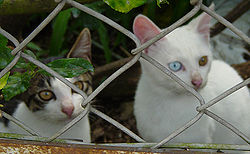Difference between revisions of "AY Honors/Cats - Advanced/Answer Key"
| Line 44: | Line 44: | ||
COAT... 10 | COAT... 10 | ||
| − | The Japanese Bobtail is a recognised breed by all major registering bodies: CFA ([http://www.cfa.org]), TICA ([http://www.tica.org]), FIFe; Shorthair only ([http://www.fifeweb.org])with the exception of GCCF (UK). | + | The Japanese Bobtail is a recognised breed by all major registering bodies: CFA ([http://www.cfa.org]), TICA ([http://www.tica.org]), FIFe; Shorthair only ([http://www.fifeweb.org]) with the exception of GCCF (UK). |
==General== | ==General== | ||
Revision as of 17:48, 8 April 2006
The Japanese Bobtail is a breed of cat with an unusual 'bobbed' tail more closely resembling the tail of a rabbit than that of an ordinary feline. The short tail is caused by the expression of a recessive gene. Thus, so long as both parents are bobtails, all kittens born to a litter will have bobtails as well. Unlike the Manx and other cat breeds, where genetic disorders are common to tailless or stumpy-tails, no such problem exists with the Japanese Bobtail.
The bobtail is a small oriental cat native to Japan and Southeast Asia. The breed has been known in Japan for centuries, and there are many legends and myths, as well as pieces of ancient art, featuring it. The Maneki Neko, or 'beckoning cat' is a bobtail.
Japanese bobtails may have almost any colour, but calico (called "Mi-ke", meaning "three-fur") or bi-colours are especially favoured by the Japanese. The Japanese Bobtail is a breed of domestic cat that originated in Japan; it is featured in many ancient prints and paintings.
History
The earliest written evidence of cats in Japan indicates that they arrived from China or Korea at least 1,000 years ago. In 1602, Japanese authorities decreed that all cats should be set free to help deal with rodents threatening the silk-worms. Buying or selling cats was illegal, and from then on, bobtailed cats lived on farms and in the streets. So,the Japanese Bobtails are the "street cats" of Japan. The beckoning cat, which is a Bobtail seated with one paw raised, is considered to be a good-luck charm. A maneki-neko statue is often found in the front of stores. Look around the next Japanese restaurant you visit you’ll likely spot one. In 1968 the late Elizabeth Freret imported the first three Japanese Bobtails to the United States from Japan. In 2001 the first registered litter of Bobtails in the UK were bred under the "Solstans" prefix.
Breed Standard
Head: The head should form an equilateral triangle. (Not including ears)
Ears: Large, upright, set wide apart but at right angles to the head and looking as if alert.
Muzzle: Fairly broad and round neither pointed nor blunt.
Eyes: Large, oval rather than round. They should not bulge out beyond the cheekbone or the forehead.
Body: Medium in size, males larger than females. Long torso, lean and elegant, showing well developed muscular strength. Also balance is very very important.
Neck: Not too long and not too short, in proportion to the length of the body.
Legs: Long, slender, and high. The hind legs longer than the forelegs.
Paws: Oval. Toes: five in front and four behind.
Coat (Shorthair): Medium length, soft and silk.
Coat (Longhair): Length medium-long to long, texture soft and silky gradually lengthening toward the rump.
Tail: The tail must be clearly visible and is made up of one or more curves.
POINT SCORE HEAD... 20 TYPE... 30 TAIL... 20 COLOR and MARKINGS... 20 COAT... 10
The Japanese Bobtail is a recognised breed by all major registering bodies: CFA ([1]), TICA ([2]), FIFe; Shorthair only ([3]) with the exception of GCCF (UK).
General
Japanese Bobtails usually have litters of three to four kittens with newborns that are unusually large compared to other breeds. They are active earlier, and walk earlier. Affectionate and generally sweet-tempered, they enjoy supervising household chores and baby-sitting. They are active, intelligent, talkative cats with a well-defined sense of family life. Their soft voices are capable of nearly a whole scale of tones; some people say they sing. Since they adore human companionship they almost always speak when spoken to. Because of their human-oriented personality they are easy to teach tricks and enjoy learning things like walking on a harness and lead.
Ocular Heterochromia
While rare, Japanese Bobtails, especially predominantly white specimens, are more likely than other breeds to express heterochromia, or differing iris colours. One eye will be blue while the other is yellow (though in Japan, blue is referred to as silver while yellow is referred to as gold). This trait is popular and kittens displaying this "odd-eye" feature are usually more expensive.


